Menu
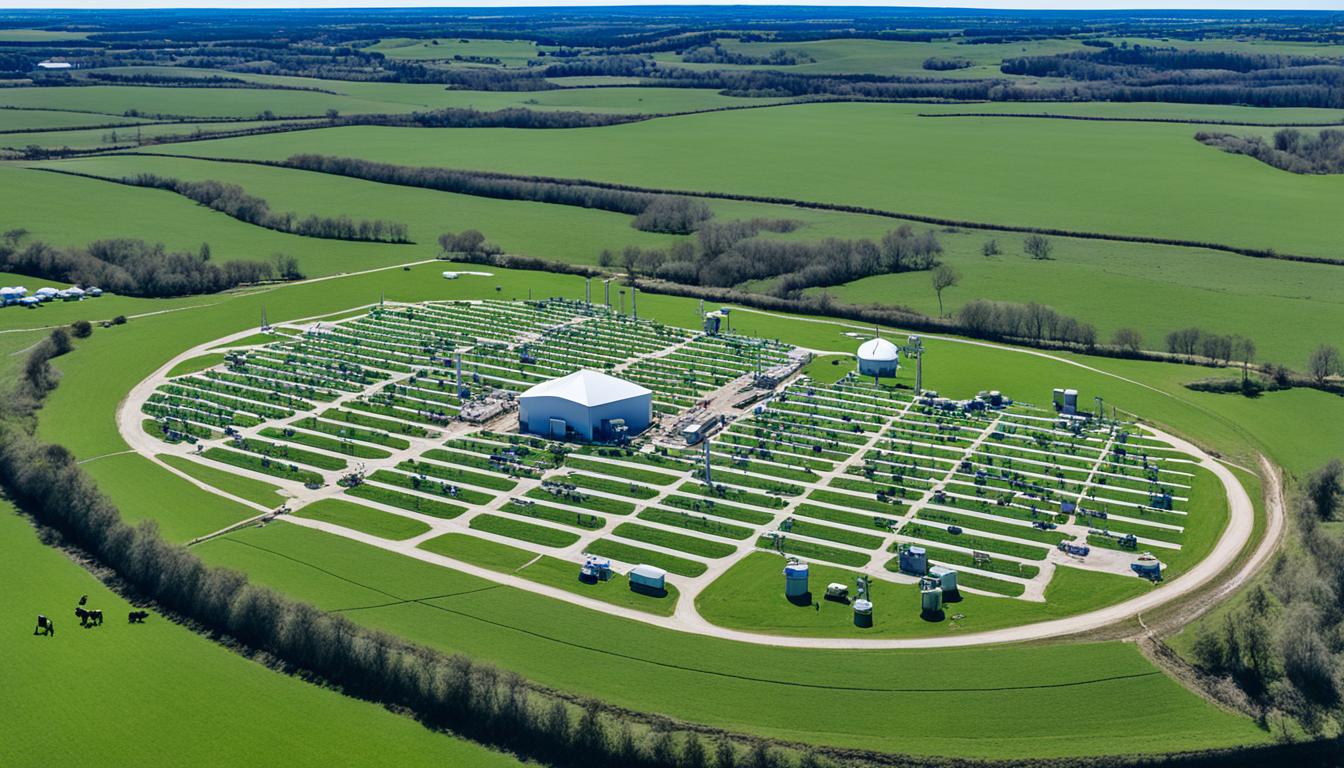
In 2016, sensors made up over half of the hardware and systems market for livestock tech. This shows how fast livestock monitoring technology is growing. It’s mainly because of more use of the Internet of Things (IoT). By 2029, the market for livestock IoT is expected to be worth over USD 11 billion.
At Environment.co, I’ve watched how new tech is linking with farming and agriculture. This change is making farming better for animals and people. One leading trend is precision livestock farming (PLF). It uses things like smart collars and sensors to improve how we look after animals.
But, in the U.S., not many farms are using PLF yet. Only about 27% have tried it by 2023. However, more farms are becoming interested. Wearables that use AI can spot if an animal is acting differently or might be sick. These tools help farmers look after their animals better, but they need to fit well with other systems to work best.
The way we watch over livestock has changed a lot. In the past, people mainly looked at animals to check their health. This required a lot of time and effort. But, it didn’t give a full picture of the animals’ health.
Back then, checking on animals had many flaws. Farmers could not see the full health story this way. They mainly observed how animals looked. This was not enough to spot signs of sickness early or help animals feel less stressed.
Today, technology has made huge steps forward in keeping animals healthy. Things like IoT have brought in devices and tools to watch animals all the time.
These systems use sensors and even AI to track animals and predict health problems. This helps farmers act before an issue becomes serious.
New gadgets have taken the lead in keeping our animals better. For example, devices like accelerometers can tell us a lot about an animal’s health by checking how they move. RFID systems help in finding and keeping track of every animal.
Bringing AI into this mix helps cut costs and improve how we farm. It does this by offering suggestions based on data from the sensors. This way, farmers can make better choices.
All these advancements reflect a bigger move towards smarter farming. The industry is growing fast because of these new tools. Experts predict by 2029, it will be worth over USD 11 billion. This change is not only good for the animals. It’s also critical for farms to work better and last longer.
| Advances | Traditional Methods | Modern Technologies |
|---|---|---|
| Observation | Manual checks | Automated sensors |
| Health Monitoring | Intermittent | Continuous real-time tracking |
| Animal Welfare | Labour-intensive | AI-based predictive analytics |
| Costs | High | Reduced through AI integration |
The change in monitoring livestock is a big deal. It shows how new trackers and health tools are key to making sure animals are well cared for. And at the same time, they help farms run smoother.
Precision livestock farming (PLF) is changing agriculture. It includes high-tech systems and gadgets that look after animals well. With about 70 billion farm animals and over 93 billion animals killed for food each year, PLF is crucial. It uses things like heart rate monitors and biometric tools to help animals and farms work better.
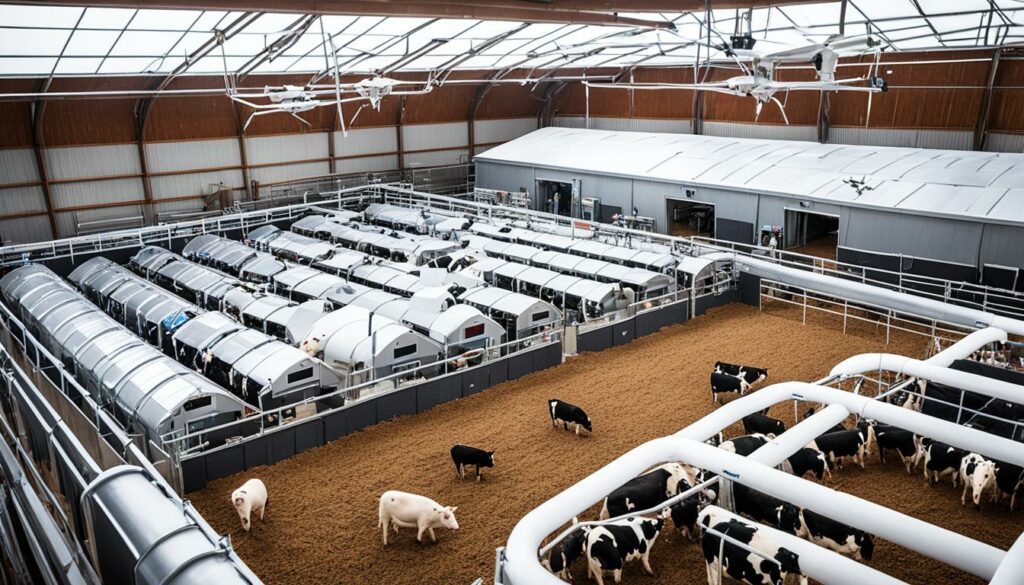
PLF uses sensors to keep animals in the best environment. Meat eating has doubled between 1980 and 2002, and it’s expected to double again by 2050. This is where the Internet of Things (IoT) in farming is so important. It helps monitor the environment’s health, as the farming industry emits a lot of greenhouse gases.
Watching how animals behave is also a big part of PLF. In the future, farms could be as big as managing 15,000 dairy cows. With smart data and environmental sensors, PLF tailors care for each animal. This not only helps farms produce more but also reduces their environmental harm.
| Feature | Traditional Farming | Precision Livestock Farming |
|---|---|---|
| Monitoring Method | Manual Observation | Automated Systems |
| Data Collection | Intermittent Checks | Continuous Monitoring |
| Health Management | Reactive Treatment | Proactive Care |
| Labour Efficiency | High Labour Demand | Reduced Labour Time |
| Environmental Impact | Higher Emissions | Optimised Emissions |
Using IoT in farming and new PLF tools, like automatic weighing systems, will keep improving. These changes make sure that as more people need food from animals, our planet stays healthy.
IoT in agriculture is changing how farmers look after their animals. The use of infrastructure technology is key. It helps to set up a system where different IoT devices can work together.
Sensors were a big part of technology in 2016, making up 51 percent. For farms, these sensors are crucial in managing livestock with IoT. They give instant updates on the health of animals. Things like Wi-Fi and Bluetooth help send this data without any hassle.
At the core of IoT on farms is a strong tech base. It supports how different gadgets talk to each other. With tools like gateways and actuators, data moves smoothly. This means animals are checked carefully to keep them healthy and spot problems early.
Collecting and sending data the right way is vital in IoT for farms. Sensors pick up lots of info which is then sent on through devices. This data collection makes it easy to watch over animals and know if something’s wrong quickly. It helps farmers predict health issues and make their job more efficient.
The IoT farming market is expected to get a boost, growing by 12.1% each year. By 2029, it could be worth USD 11.18 billion. This kind of growth shows how much IoT tech is helping on the farm. It improves a lot of key areas, making farming greener and smarter.
Adding remote animal monitoring to farms has lots of benefits. These help with managing animals better and looking after their wellbeing. A key advantage is the ability to gather real-time data. This changes how farmers oversee their animals.
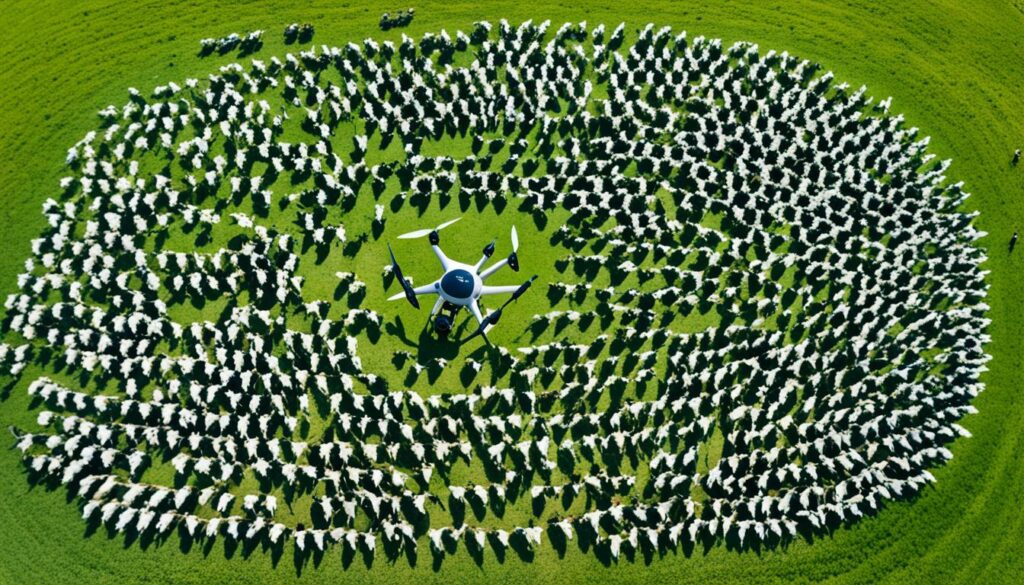
Moving on from checking animals manually, modern technology allows farmers to get insights quickly. Systems that use the internet to connect devices make this possible. This lets farmers keep a close eye on things like the animals’ temperature and how they move. And when something isn’t right, they can act fast to fix it.
RFID tags can follow what the animals do and check their vital signs. This, alongside other technologies, boosts farm work and the quality of the end product. It also means the animals live in better conditions.
Having machines watch over the animals cuts down on hard work for people. Instead of always physically checking on the animals, automated systems do the job. This means farm workers can focus on different important tasks. There are cameras that can watch animals non-stop, and they can tell when something odd happens. This makes managing animals easier and means less effort for the farm team.
With more and more farms using tech like this, it shows we’re moving ahead in farming. Real-time data and less manual work make farm work smarter and more efficient.
| Advantages | Impact |
|---|---|
| Real-time Data Collection | Immediate responses to health issues, enhanced productivity |
| Reduced Manual Labour | Reallocated resources, minimised physical demands |
| 24-hour Video Surveillance | Continuous monitoring without human intervention |
| RFID Tracking | Efficient herd management, accurate health monitoring |
InThe changing world of farming, tracking devices for animals are now key. They help farmers keep a close eye on their animals. By using GPS and RFID, farmers get a detailed look at their herds. This makes things run better and helps keep the animals well.
GPS trackers have changed how we look after animals, giving updates on where they are. They:
Using GPS tech also fits well with other systems like LoRaWAN® and Digital Matter. This helps farmers around the world do more and keep their farms safe.
RFID tags offer a smart way to watch over animals. Put in collars or on the animals, tracking is easy. This makes keeping track and managing the animals more efficient.
Big names in farming like AgResearch and DairyNZ use RFID to learn more about animals. This tech is vital for a greener, healthier, and more productive farm life.
Here are the advantages of the top livestock trackers:
| Device | Features | Application |
|---|---|---|
| FaunaTech Livestock Monitor | Real-time tracking, continuous health monitoring | Optimising pasture use, offering useful insights |
| Yabby Edge | Battery-powered, geofencing, load tracking | Tracking bees, watching over livestock with dogs |
| Lonestar Tracking | Battery-powered IoT tracking, monitoring | Making sure Texas ranch animals are safe |
By bringing together GPS and RFID trackers, farming is becoming smarter and more efficient. It boosts both farm work and animal care.
Smart farming solutions are changing agriculture with advanced technologies for animal health monitoring. They use AI-based technologies to improve accuracy and efficiency. These advancements are key for farmers and ranchers. AI sensors can quickly spot changes in body temperature and activity, helping to identify health issues early.
Modern farming leans heavily on automated surveillance systems. These systems cut down on manual work and time needed for looking after animals. This boosts productivity and profits. Drones and remote monitoring are changing the game by offering real-time data. They make it easier to respond fast to health problems.
AI is also used to improve what animals eat. It tailors food plans to meet each animal’s needs. This makes animal diets more efficient and keeps them healthy. AI analytics help farmers reduce their farms’ impact on the environment. This supports more eco-friendly practices.
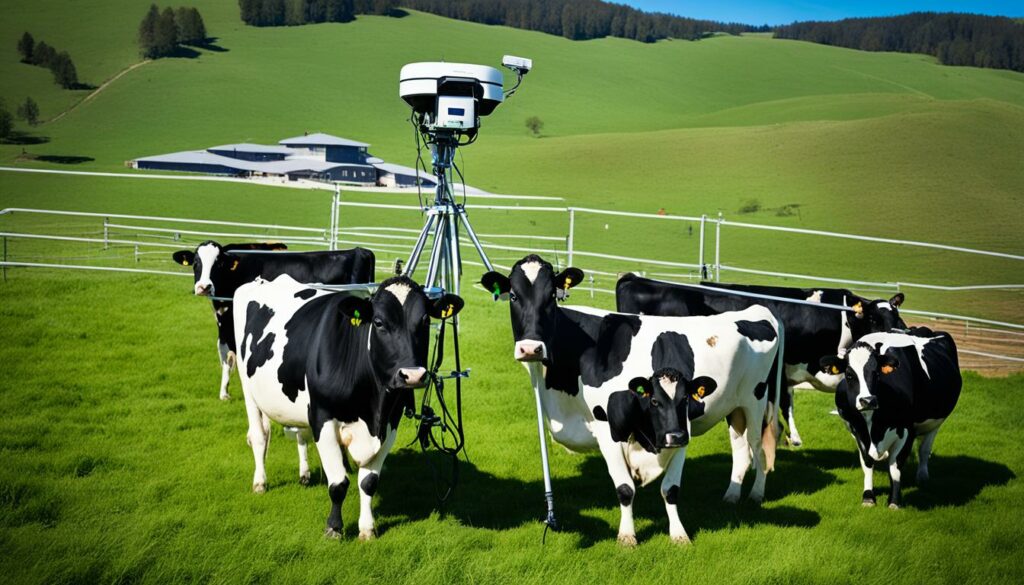
Companies are investing in smart farming to boost livestock health monitoring. Groups like AgJunction, Raven Industries, and Nedap lead the way. They use advanced AI and data analytics to enhance how we manage animals. This focus on automation and precision is reshaping agriculture. It’s leading to farming that is more sustainable and adaptive.
| Technology | Function | Benefits |
|---|---|---|
| Automated Surveillance Systems | Remote monitoring of livestock | Real-time data, reduced manual labour |
| AI Sensors | Health monitoring and early disease detection | Early intervention, improved animal health |
| AI Algorithms | Optimising nutrition programs | Increased feed efficiency, better growth |
| Drones | Aerial monitoring of livestock | Comprehensive surveillance, safety assurance |
Digital agriculture solutions have changed farming for the better. They make farming more efficient and sustainable. It’s cool to see how tech helps the agriculture world.
Digital solutions make farming operations more efficient. They include sensors, drones, and machines that collect data in real time. These tools help farmers do their work with great precision. For example, more dairy farms are starting to use robots. This change means fewer people are doing manual work on the farms.
There are many tools like software for managing feed and devices that check on cows. They all work together to give farmers a better understanding of their farm. This helps them make smarter choices. At Purdue University, researchers are using these tools to help manage livestock better. They also use drones and artificial intelligence for smart farming.
Digital solutions help make farming practices more sustainable. They cut down on waste and help resources last longer. For example, sensors can keep track of where animals graze. This means they don’t overgraze parts of the land. It helps protect the environment.
Working together is key for making these solutions work and for solving problems. For example, organisations like CNFA work with farmers to make agriculture better. The focus is on solutions that help both the environment and the farmers.
| Aspect | Technological Advancement | Impact |
|---|---|---|
| Dairy Robotics | From 12% to 20% adoption expected | Streamlined processes, reduced labour |
| Virtual Fencing | Sensors for pasture movement | Optimised grazing, reduced environmental footprint |
| Collaboration | Interdisciplinary work | Enhanced efficiency and sustainability |
Geofencing changes how we look after animals, with precise alerts on their whereabouts. It uses GPS and RFID technology to set up digital fences. If an animal goes out of bounds, it alerts us.
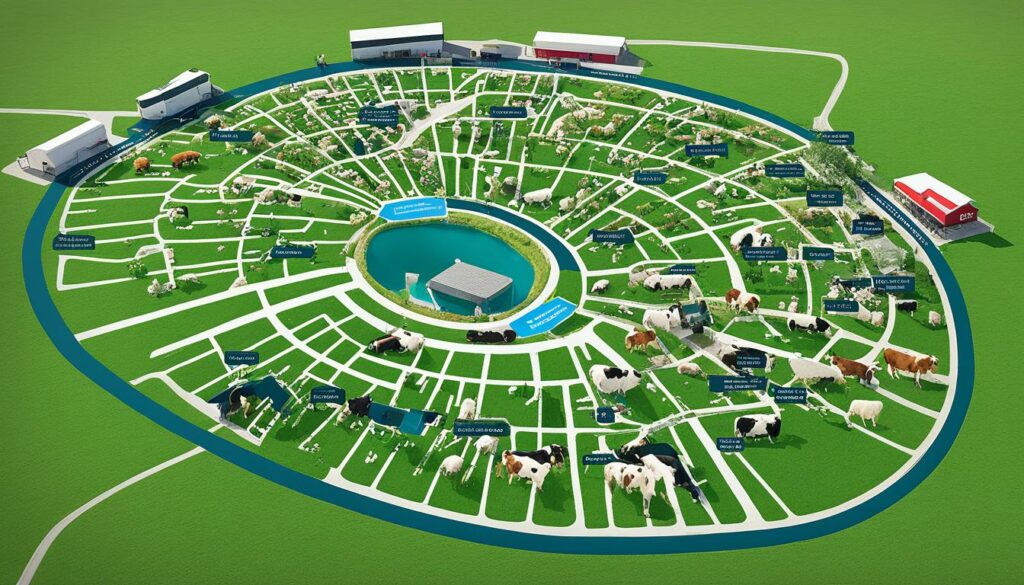
Geofencing makes digital perimeters for animals with IoT and GPRS. This means farmers can watch over their livestock from afar.
Data from sensors gives details on where the animals are and their condition. It’s a huge leap in how farmers keep an eye on their herds.
It’s key for keeping animals safe, stopping them from going somewhere they shouldn’t. Using GPS and drones, farmers can look after their animals in real-time from a distance. This also means no physical fences are needed.
And, tech enhances this by spotting odd behaviours early. This timely awareness keeps the animals safer.
Geofencing has taken animal care to a new level. Now, it’s at the heart of looking after farm animals today.
Artificial Intelligence (AI) is changing the way we care for animals. It offers new ways to monitor livestock. This not only builds on old methods but offers a detailed look into animal behaviour and health through data.
AI plays a vital role in understanding animal behaviour. It can pick up on small changes that humans might miss. Tools like SwineTech help watch over piglets, cutting down on piglet deaths by 31.37%. AI is also trained to spot when animals move oddly, a sign they might be sick or hurt. This early warning leads to better and quicker care.
AI is key in spotting diseases early. It uses vision AI and machine learning to keep an eye on animals. This tech can find signs of illness quickly in places like poultry farms. It gives farmers a chance to act before the problem gets worse. Beehome uses AI to watch over bee colonies, helping to keep bees healthy. Plus, Ambiq’s tools help farmers by giving constant updates on their animals’ health.
Thermal imaging and cameras are changing how farmers look after their animals. They help spot health problems early without disturbing the animals. For instance, they can catch conditions like Mastitis swiftly. This one health issue costs European farmers a lot, with dairy farmers enduring big losses yearly.
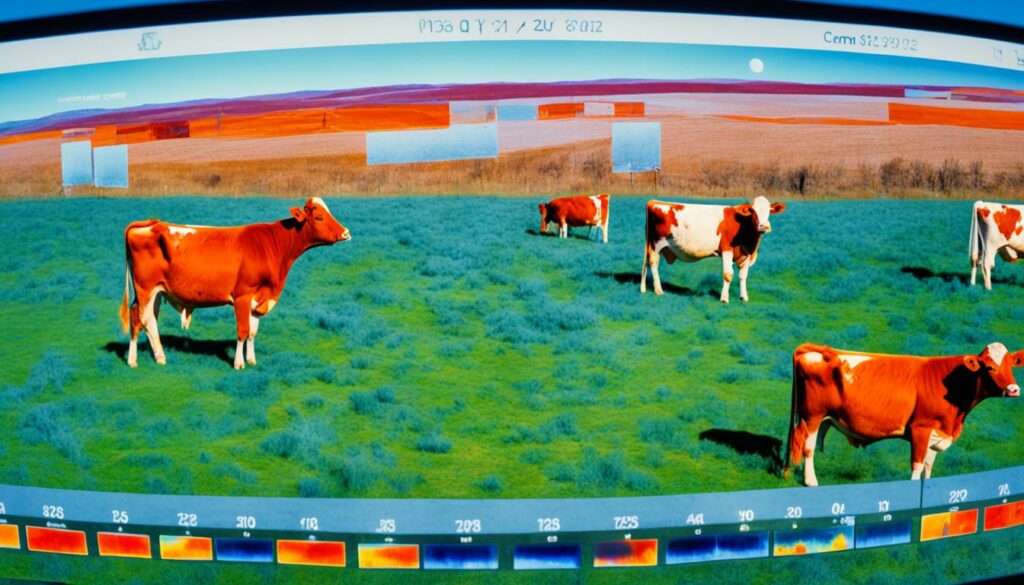
The FLIR A310 is a top thermal imaging camera. It captures detailed thermal images, highlighting even the smallest temperature changes. The CaDDi system, which it’s part of, uses this data to find signs of Mastitis early. It’s a smart way to keep track of cows’ health, without manual checks.
This system isn’t just for Mastitis. They want to use it to find other problems too, like nerve damage. By checking on animals this way, farms will have fewer health-related issues. This means better care for the animals and more efficient farming.
| Feature | Details |
|---|---|
| FLIR A310 Resolution | 320 x 240 pixels |
| Thermal Sensitivity | 50mK |
| Mastitis Cost Range | 20,000 – 60,000 Euros/year |
| Technology Utilised | RFID, Self-Learning Database |
By using these technologies, farmers can act faster when their animals need help. This leads to healthier animals and better farm management. In the end, it boosts both the farm’s income and the well-being of the animals.
Blockchain technology has changed the game in farming, especially in traceability and supply chain transparency. It makes every deal safe and unchangeable, acting as a secure digital record book.
In the farming industry, keeping data safe is vital, and blockchain is a big help here. Because it’s not controlled by one person, nobody can mess with the records. This stops food fraud, saving a lot of money worldwide. Combined with the fact that only 20% of us really trust companies to keep our food safe, blockchain’s safeguarding of facts is a real game-changer.
Transparency in the food chain is a big plus of blockchain in farming. Europe’s fenugreek seed incident is a strong example of what goes wrong without traceability. Systems with blockchain can quickly spot spoiled foods, reducing losses and recalls. They also open up all food details to buyers, from where it came to how it was grown.
This includes even knowing where your meat comes from and how the animals were raised. Blockchain not only improves following the food trail but also shows everyone involved in making and buying food what’s really happening.
Drones and automatic systems have changed how we look after farm animals from above. With a view from the sky, it’s easier to watch over them. This new approach is making farming more efficient. The drone market in farming is growing fast and is expected to be worth more than five billion pounds by 2026. Farmers can now keep an eye on a big area all at once and see small details too, thanks to drones.
One big advantage of drones is how quickly they cover large areas. This is key when checking on animal health and where they are. Drones with special cameras and tracking equipment can give instant updates. Imagine being able to keep close watch on a farm animal, even when you’re not right there.
This way, farmers can spot problems early and prevent the loss of animals. On some farms, up to a fifth of lambs and five percent of ewes are lost every year. Thanks to drones, these losses are dropping. This shows just how important drones are in modern farming.
Drones are also used for making sure animals are safe. Take New Zealand, for example, with almost 27 million sheep. Drones there help to check for diseases, keeping animals healthier. In the UK, where theft of sheep is a big problem, drones are used for security. They help protect animals and make it easier to keep them where they should be.
Drones do more than just keep animals safe. They also make managing fields better and looking after sheep easier. By using these flying tools, we’re taking animal care to a whole new level. This makes old-fashioned ways of looking after animals even more effective.
Livestock monitoring technology improves animal care. It gives real-time data and cuts down on manual work. This tech also boosts the health and productivity of the animals.
Before, monitoring livestock was mostly done by people watching the animals. Now, we have IoT and digital farming. These let us watch the animals all the time, checking on their health always.
PLF uses high-tech tools to take care of animals one by one. It watches how they act and notices if they get sick. All this is thanks to the internet in farming.
IoT makes monitoring animals better by using sensors and the internet. It gives farmers instant data about the animals and their surroundings. This helps make better choices for the animals and their care.
Watching animals far away and in real-time is very helpful. It means less work for people and quick responses to problems. This makes looking after animals more efficient.
Devices like GPS and RFID help farmers know exactly where their animals are. They also help keep track of how many animals there are. This makes it easier to manage the farm well.
There are drones, special sensors, and cameras that can keep an eye on the animals. They check their health, movements, and help the weakest ones. This makes farms stronger overall.
Digital farming makes work easier by doing tasks automatically. It saves money and helps use resources better, without harming the environment. Both the farm’s economy and the Earth benefit.
Geofencing creates virtual borders with GPS and RFID. This helps watch over animal movement safely. It sends alerts if they go somewhere they shouldn’t. This makes managing the herd simpler.
AI studies how animals behave and spots when they’re sick early. It does a better job than just watching the animals. This means they’re taken better care of.
Cameras and thermal images check on animals without bothering them. They catch health problems early by looking at their temperature and actions. This helps care for them better.
Blockchain makes data secure and stops lies and theft. It makes the whole supply chain more honest with unchangeable records. This helps everyone in farming.
Drones and automatic systems can cover lots of ground and help in emergencies. They keep an eye on animals that need extra care all the time. This means better ways to look after the animals on the farm.